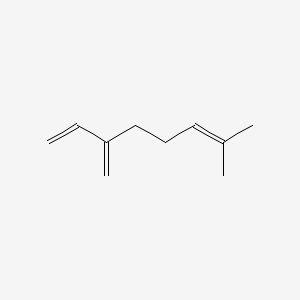| Authors | Title | Published | Journal | PubMed Link |
|---|---|---|---|---|
| Rains GC et al. | Behavioral monitoring of trained insects for chemical detection. | 2006 Jan-Feb | Biotechnol. Prog. | pmid:16454485 |
| van Schie CC et al. | Tomato linalool synthase is induced in trichomes by jasmonic acid. | 2007 | Plant Mol. Biol. | pmid:17440821 |
| Blanch JS et al. | Sensitivity of terpene emissions to drought and fertilization in terpene-storing Pinus halepensis and non-storing Quercus ilex. | 2007 | Physiol Plant | pmid:18251893 |
| Green S et al. | Unusual features of a recombinant apple alpha-farnesene synthase. | 2007 | Phytochemistry | pmid:17140613 |
| Barra A et al. | Characterization of the volatile constituents in the essential oil of Pistacia lentiscus L. from different origins and its antifungal and antioxidant activity. | 2007 | J. Agric. Food Chem. | pmid:17658828 |
| Sylvestre M et al. | Composition and cytotoxic activity of the leaf essential oil of Comptonia peregrina (L.) Coulter. | 2007 | Phytother Res | pmid:17326040 |
| Nikolić B et al. | Variability of the needle essential oils of Pinus heldreichii from different populations in Montenegro and Serbia. | 2007 | Chem. Biodivers. | pmid:17510986 |
| Terry I et al. | Odor-mediated push-pull pollination in cycads. | 2007 | Science | pmid:17916726 |
| Abu-Lafi S et al. | Natural compounds of Palestine flora. Comparison analysis by static headspace and steam distillation GC-MS of semivolatile secondary metabolites from leaves of cultivated Palestinian Majorana syriaca. | 2007 | Biomed Pap Med Fac Univ Palacky Olomouc Czech Repub | pmid:17690735 |
| Flamini G and Cioni PL | Seasonal variation of the chemical constituents of the essential oil of Santolina etrusca from Italy. | 2007 | Chem. Biodivers. | pmid:17510997 |
| Lu M et al. | Cross-attraction between an exotic and a native pine bark beetle: a novel invasion mechanism? | 2007 | PLoS ONE | pmid:18074026 |
| Kong JO et al. | Nematicidal and Propagation Activities of Thyme Red and White Oil Compounds toward Bursaphelenchus xylophilus (Nematoda: Parasitaphelenchidae). | 2007 | J. Nematol. | pmid:19259493 |
| Ro DK et al. | Induction of multiple pleiotropic drug resistance genes in yeast engineered to produce an increased level of anti-malarial drug precursor, artemisinic acid. | 2008 | BMC Biotechnol. | pmid:18983675 |
| Paaver U et al. | Phytochemical analysis of the essential oil of Thymus serpyllum L. growing wild in Estonia. | 2008 | Nat. Prod. Res. | pmid:18075894 |
| Qiao Y et al. | Characterization of aroma active compounds in fruit juice and peel oil of Jinchen sweet orange fruit (Citrus sinensis (L.) Osbeck) by GC-MS and GC-O. | 2008 | Molecules | pmid:18596659 |
| Shibahara F et al. | Diene hydroacylation from the alcohol or aldehyde oxidation level via ruthenium-catalyzed C-C bond-forming transfer hydrogenation: synthesis of beta,gamma-unsaturated ketones. | 2008 | J. Am. Chem. Soc. | pmid:18841895 |
| Barbosa LC et al. | Evaluation of the chemical composition of Brazilian commercial Cymbopogon citratus (D.C.) stapf samples. | 2008 | Molecules | pmid:18794790 |
| Lee JH et al. | Chemical composition and antimicrobial activity of essential oil from cones of Pinus koraiensis. | 2008 | J. Microbiol. Biotechnol. | pmid:18388468 |
| Russo EB | Cannabinoids in the management of difficult to treat pain. | 2008 | Ther Clin Risk Manag | pmid:18728714 |
| Sandstrom P et al. | Myrcene hydroxylases do not determine enantiomeric composition of pheromonal ipsdienol in Ips spp. | 2008 | J. Chem. Ecol. | pmid:19034575 |
Myrcene
Myrcene is a lipid of Prenol Lipids (PR) class. Myrcene is associated with abnormalities such as Hypomenorrhea, abnormal fragmented structure, Nephrosis, Renal tubular disorder and Kidney Diseases. The involved functions are known as Anabolism, Gene Expression, Protein Biosynthesis, Mutation and Selection, Genetic. Myrcene often locates in Plastids, Proboscis, Body tissue, Clone and soluble. The associated genes with Myrcene are TTPA gene, monoterpene synthase, Genome, 4S-limonene synthase and Homologous Gene. The related lipids are Pinene, Octanols, Membrane Lipids and Fatty Acids, Unsaturated.
Cross Reference
Introduction
To understand associated biological information of Myrcene, we collected biological information of abnormalities, associated pathways, cellular/molecular locations, biological functions, related genes/proteins, lipids and common seen animal/experimental models with organized paragraphs from literatures.
What diseases are associated with Myrcene?
Myrcene is suspected in Nephrosis, Kidney Diseases, Dehydration, Hypomenorrhea, Renal tubular disorder and other diseases in descending order of the highest number of associated sentences.
Related references are mostly published in these journals:
| Disease | Cross reference | Weighted score | Related literature |
|---|
No disease MeSH terms mapped to the current reference collection.
PubChem Associated disorders and diseases
What pathways are associated with Myrcene
There are no associated biomedical information in the current reference collection.
PubChem Biomolecular Interactions and Pathways
Link to PubChem Biomolecular Interactions and PathwaysWhat cellular locations are associated with Myrcene?
Visualization in cellular structure
Associated locations are in red color. Not associated locations are in black.
Related references are published most in these journals:
| Location | Cross reference | Weighted score | Related literatures |
|---|
What functions are associated with Myrcene?
Related references are published most in these journals:
| Function | Cross reference | Weighted score | Related literatures |
|---|
What lipids are associated with Myrcene?
Related references are published most in these journals:
| Lipid concept | Cross reference | Weighted score | Related literatures |
|---|
What genes are associated with Myrcene?
Related references are published most in these journals:
| Gene | Cross reference | Weighted score | Related literatures |
|---|
What common seen animal models are associated with Myrcene?
There are no associated biomedical information in the current reference collection.
